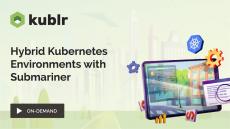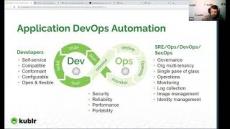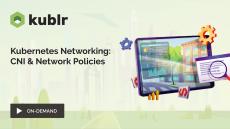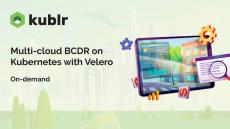Imagine this scenario: You deploy your Kubernetes cluster using Kublr and integrate Ceph storage into the mix effortlessly. Suddenly, all your managed Kubernetes clusters gain access to Ceph, leveraging its features to enhance performance, reliability, and scalability. With Ceph added to the mix, data storage in Kublr becomes even more streamlined.
|
By Kublr Team
As Kubernetes solidifies its position as the standard for container orchestration, it’s imperative to examine the associated security challenges. Kubernetes brings powerful capabilities to the enterprise and introduces new attack vectors and potential vulnerabilities. Here at Kublr, we sat down with our best experts to discuss how our team solves security challenges and how Kublr helps clients mitigate them.
|
By Kublr Team
Kublr team is happy to announce the new release 1.27, which we have been carefully crafting in previous months. At Kublr, we support six different versions of Kubernetes and a bunch of different clouds, so our team is focused on thoroughly testing each changed component and maintaining backward compatibility.
|
By Kublr Team
The rise of containerization has precipitated an unprecedented shift in the software development landscape, with Kubernetes emerging as the de facto standard for managing large-scale containerized applications. One of the more nuanced aspects of Kubernetes that is gaining attention is multi-cluster orchestration. This approach to cluster management offers several compelling advantages that reshape how businesses operate and innovate in a cloud-native context.
|
By Kublr Team
Kubernetes has emerged as the gold standard in container orchestration. As with any intricate system, there are many nuances and challenges associated with Kubernetes. Understanding how networking works, especially regarding network policies, is crucial for your containerized applications' security, functionality, and efficiency. Let’s demystify the world of Kubernetes network policies.
|
By Kublr Team
The world of DevOps is constantly evolving and adapting to the needs of the software development industry. With the increasing demand for faster and more efficient software delivery, organizations are turning to modern technologies and practices to help them meet these challenges. In a series of articles on the Kublr blog, we will take a look at some of today’s top DevOps trends.
|
By Kublr Team
The Kublr team is excited to announce the general availability of version 1.25, providing customers with the most flexibility and customization possible to manage their Kubernetes-based infrastructure via Kublr’s single pane of glass, to-date.
|
By Kublr Team
The world of DevOps is constantly evolving and adapting to the needs of the software development industry. With the increasing demand for faster and more efficient software delivery, organizations are turning to modern technologies and practices to help them meet these challenges. In this series of articles on the Kublr blog, we will look at some of today’s top DevOps trends.
|
By Kublr Team
The world of DevOps is constantly evolving and adapting to the needs of the software development industry. With the increasing demand for faster and more efficient software delivery, organizations are turning to modern technologies and practices to help them meet these challenges. In a series of articles on the Kublr blog, we will take a look at some of today’s top DevOps trends.
|
By Kublr Team
The world of DevOps is constantly evolving and adapting to the needs of the software development industry. With the increasing demand for faster and more efficient software delivery, organizations are turning to modern technologies and practices to help them meet these challenges. In a series of articles on the Kublr blog, we will take a look at some of today’s top DevOps trends.
|
By Kublr
Submariner enables direct networking between pods and services in different Kubernetes clusters, either on-premise or in the cloud. Why Submariner? As Kubernetes gains adoption, teams are finding they must deploy and manage multiple clusters to facilitate features like geo-redundancy, scale, and fault isolation for their applications. With Submariner, your applications and services can span multiple cloud providers, data centers, and regions.
|
By Kublr
Watch the replay on implementing hermetic reproducibility with the Bazel build tool presented by Oleg Chunikhin, Co-Founder & CTO of Kublr.
|
By Kublr
Container runtimes and tools have multiplied and matured since Docker brought containers to the mainstream a decade ago. So which of the many options available should developers and system administrators choose for building and running containers? In this cannot-miss webinar, Oleg Chunikhin, CTO at Kublr, will provide a review and analysis of the most popular options to help you make the very best choice for your environment.
|
By Kublr
In this webinar, Oleg Chunikhin, CTO at Kublr, walks you through the basics of Kubernetes (K8s) persistence management functionality and how it can be used to simplify managing persistent applications across different environments - in the cloud or on-premise. Oleg will use a demo environment with clusters in different clouds to show K8s persistence in action. Learn about.
|
By Kublr
Learn how the Ceph storage system can be deployed and managed quickly and reliably using Rook, Kubernetes (K8s) and Kublr in Azure & AWS. Learn how to use Ceph in heterogeneous hybrid & multi-cloud environments to enable data replication, mirroring and disaster recovery. Learn how Ceph and Rook provide cloud-native K8s applications with block and file storage & advanced capabilities like snapshots and volume cloning.
|
By Kublr
In this webinar, Oleg, CTO at Kublr, will show how Kubernetes (K8s) networking stack works, describe main components, interfaces, and extensibility options.
|
By Kublr
In this webinar, you'll see Velero BCDR framework in action and a demonstration of how it can be used to back up and recover realistic applications running on Kubernetes in different clouds and environments.
|
By Kublr
Kublr is an enterprise-grade Kubernetes management platform. Headquartered in Washington, D.C. and launched in 2016, Kublr automates the deployment and management of production-ready, secure Kubernetes clusters and environments. Kublr allows users to securely and reliably deploy, run, and manage containerized applications at scale. A subsidiary of EastBanc Technologies, Kublr is a proud contributor to the Kubernetes codebase, an active member of the Cloud Native Computing Foundation, and completed the CNCF Kubernetes Software Conformance Certification program.
|
By Kublr
Kublr is an enterprise-grade Kubernetes management platform. Headquartered in Washington, D.C. and launched in 2016, Kublr automates the deployment and management of production-ready, secure Kubernetes clusters and environments. Kublr allows users to securely and reliably deploy, run, and manage containerized applications at scale. A subsidiary of EastBanc Technologies, Kublr is a proud contributor to the Kubernetes codebase, an active member of the Cloud Native Computing Foundation, and completed the CNCF Kubernetes Software Conformance Certification program.
|
By Kublr
In this video, Oleg, CTO at Kublr, will explain the basics of Kubernetes (K8s) Ingress traffic management functionality and how it can be used to simplify managing applications across different environments – in the cloud or on premise. Oleg will use a demo environment with clusters in different clouds to show K8s Ingress in practice.
|
By Kublr
At the core of DevOps, Kubernetes promises IT teams unprecedented flexibility. While adoption is inevitable; the challenge lies in how to do so in an efficient and cost-effective way.
- February 2024 (1)
- November 2023 (2)
- September 2023 (2)
- June 2023 (1)
- April 2023 (2)
- March 2023 (1)
- February 2023 (1)
- November 2022 (2)
- July 2022 (1)
- June 2022 (1)
- May 2022 (2)
- April 2022 (1)
- March 2022 (2)
- February 2022 (2)
- November 2021 (3)
- October 2021 (1)
- September 2021 (1)
- July 2021 (2)
- June 2021 (2)
- May 2021 (1)
- February 2021 (2)
- January 2021 (1)
- November 2020 (1)
- October 2020 (2)
- September 2020 (2)
- August 2020 (4)
- July 2020 (6)
- June 2020 (4)
- May 2020 (3)
- April 2020 (8)
- March 2020 (3)
- February 2020 (2)
- January 2020 (1)
- December 2019 (3)
- November 2019 (3)
- October 2019 (1)
- September 2019 (3)
- August 2019 (9)
- July 2019 (2)
- March 2019 (1)
- June 2018 (3)
Centrally deploy, run, and manage Kubernetes clusters across all of your environments with a comprehensive container orchestration platform that finally delivers on the Kubernetes promise. Optimized for large enterprises, Kublr is designed to provide multi-cluster deployments and observability. We made it easy, so your team can focus on what really matters: innovation and value generation.
Deploy, Run and Manage Kubernetes:
- Deploy: Fully automate cluster deployments across environments -- whether on the cloud, on-prem, hybrid or even in air-gapped environments. Kublr integrates with infrastructure APIs to automate infrastructure provisioning and then deploys Kubernetes with configuration best practices.
- Run: Built-in logging and monitoring for each cluster automatically collect cluster and application metrics and events. The Kublr Agent initializes and updates nodes as needed to make sure they connect or reconnect to the cluster when there is a configuration or environment change or when the node restarts.
- Manage: Track the availability and performance of all clusters, whether on-premise or in the cloud, from a single pane of glass. Add and delete individual and groups of users and control their permissions through Kublr's IAM and RBAC capabilities. Create separate spaces for your teams to isolate Kubernetes clusters based on environment, for example, dev, QA, prod, or business unit.
Reliable, Secure Kubernetes. Bridging the gap between cloud native and enterprise reality.





















